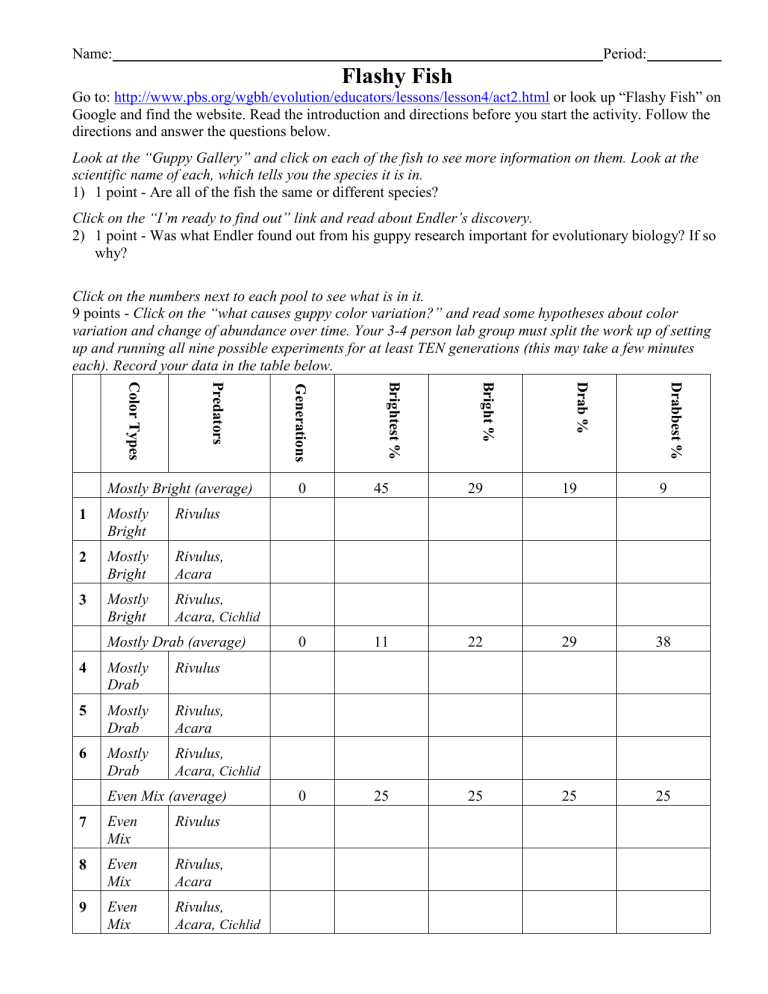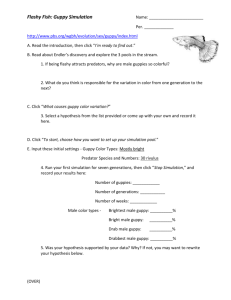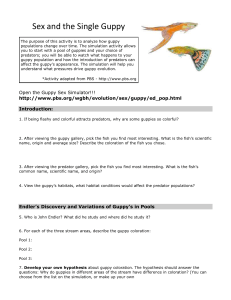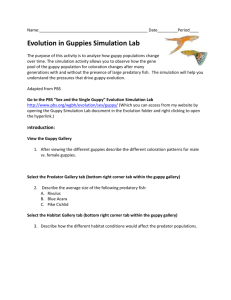Name - ehs-honors

Name: Period:
Flashy Fish
Go to: http://www.pbs.org/wgbh/evolution/educators/lessons/lesson4/act2.html
or look up “Flashy Fish” on
Google and find the website. Read the introduction and directions before you start the activity. Follow the directions and answer the questions below.
Look at the “Guppy Gallery” and click on each of the fish to see more information on them. Look at the scientific name of each, which tells you the species it is in.
1) 1 point - Are all of the fish the same or different species?
Click on the “I’m ready to find out” link and read about Endler’s discovery.
2) 1 point - Was what Endler found out from his guppy research important for evolutionary biology? If so why?
Click on the numbers next to each pool to see what is in it.
9 points Click on the “what causes guppy color variation?” and read some hypotheses about color variation and change of abundance over time. Your 3-4 person lab group must split the work up of setting up and running all nine possible experiments for at least TEN generations (this may take a few minutes each). Record your data in the table below.
Mostly Bright (average)
1 Mostly
Bright
Rivulus
2 Mostly
Bright
Rivulus,
Acara
3 Mostly
Bright
Rivulus,
Acara, Cichlid
Mostly Drab (average)
4 Mostly
Drab
Rivulus
5 Mostly
Drab
Rivulus,
Acara
6 Mostly
Drab
Rivulus,
Acara, Cichlid
Even Mix (average)
7 Even
Mix
Rivulus
8 Even
Mix
9 Even
Mix
Rivulus,
Acara
Rivulus,
Acara, Cichlid
0
0
0
11
45
25
22
29
25
38
9
25
29
19
25
Results/Discussion:
3) 1 point - Why do some guppies tend to be drabber than others (what is the advantage of being drab)?
4) 1 point - Why do some guppies tend to be more colorful (what is the advantage of being colorful)?
5) 3 points - Was the hypothesis that “predators are causing guppy populations to become more drab by preying on the most brightly colored individuals and eliminating them from the gene pool” supported by any or all of your data? If so what parts of your data and how did they support the hypothesis?
6) 3 points - Was the hypothesis that “guppy populations are evolving to more closely match their environment” supported by any or all of your data? If so what parts of your data and how did they support the hypothesis?
7) 3 points - Was the hypothesis that “guppy populations are evolving to stand out from their environment” supported by any or all of your data? If so what parts of your data and how did they support the hypothesis?
8) 3 points - Was the hypothesis that “female guppies are choosing to mate with the most brightly colored males, giving those males a higher probability of passing their genes to the next generation” supported by any or all of your data? If so what parts of your data and how did they support the hypothesis?
9) 6 points - Write a couple of paragraphs explaining the push and pull that the environment (sexual selection and predation) has on coloration of guppies in Endler’s pools.










